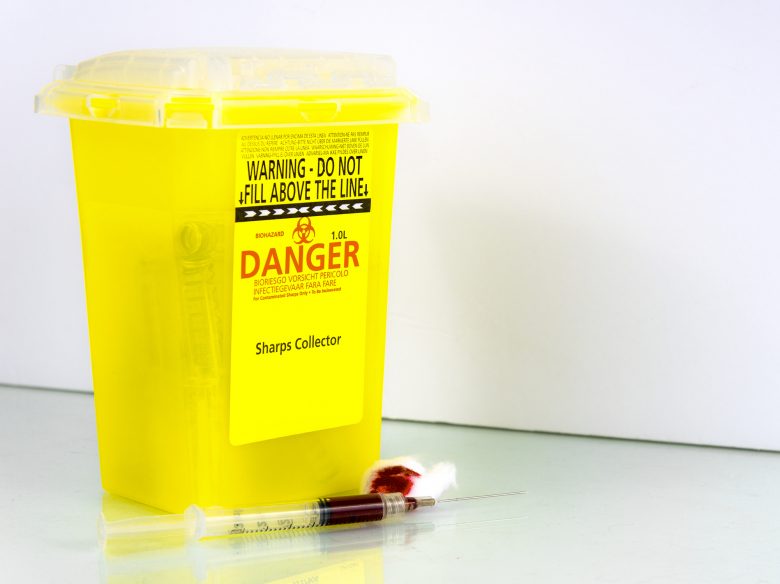Bloodborne pathogens are infectious microorganisms in human blood that include, but are not limited to, hepatitis B, hepatitis C and human immunodeficiency virus (HIV). They can infect a healthy body through contact with blood and other body fluids, secretions and excretions (except sweat) that contain infectious agents.
In many cases, contact with infected fluids happens via used needles and other sharp objects. Certain professions have a higher risk of needlestick injuries and other sharps-related injuries, and companies that employ workers who may potentially come into contact with bloodborne pathogens are required to protect their employees from this danger.
Exposure control plan
All organizations where employees have occupational exposure to blood or other potentially infectious materials (OPIM) have to follow the bloodborne pathogens standard. Employers are responsible for determining which jobs, tasks and procedures involve occupational exposure.
According to OSHA standards, occupational exposure is a “reasonably anticipated skin, eye, mucous membrane, or parenteral contact with blood or OPIM that may result from the performance of an employee’s duties.”
If your workplace carries a risk of occupational exposure to blood or OPIM, you are required to develop an exposure control plan to minimize (or eliminate) occupational exposures. Start by identifying all the hazards workers are exposed to. This exposure determination needs to contain a list of all jobs with occupational exposure and a list of the tasks and procedures that result in worker exposure. Based on this determination, you should design and implement adequate safety controls.
Implementing controls
Elimination of hazards is not feasible in some workplaces. In these situations, it’s important to follow basic controls (which includes ensuring they are relevant and structured to fit specific jobs and tasks). These controls can include, but are not necessarily limited to, the following:
- Use universal precautions. Instruct employees to treat all human blood and OPIM as if they are known to carry bloodborne pathogens.
- Implement safe practice controls, and update or redesign them as needed. For example, if performing a task differently can reduce the possibility of exposure then change the usual practice and ensure workers are trained on and follow the new, safer procedures.
- Practice safe decontamination.
- Provide personal protective equipment such as gloves, coats and masks. Remember that employers are also responsible for repairing and replacing PPE when required.
- Implement engineering controls such as sharps disposal containers and safer devices (e.g., sharps with engineered sharps injury protections and needleless systems).
- Ensure that hepatitis B vaccinations are available to all workers with occupational exposure who received the required training and within 10 days of initial assignment to a job with occupational exposure.
- Use warning labels and signs (or red bags/containers instead of labels) on containers of regulated materials, including waste, refrigerators and freezers containing blood or OPIM, contaminated equipment and contaminated laundry.
- Keep and regularly update worker medical and training records.
- Keep and regularly update a sharps injury log.
Other responsibilities
After any exposure incident (eye, mouth, other mucous membranes, non-intact skin, or parenteral contact with blood or OPIM), arrange for a post-exposure medical evaluation and make it available to the affected worker. Document the reasons for exposure and test the source individual (the person whose blood or other body fluids came into contact with the worker in an unsafe manner) for hepatitis B and HIV infections. Employers are also required to offer the exposed worker post-exposure prophylaxis and counseling.
The company exposure control plan should be reviewed and updated annually to reflect any workplace changes that might affect safe work procedures. Employers should also make changes to engineering and practice controls based on input from workers.
Workers need to receive regular training that covers all aspects of the exposure control plan such as information on bloodborne pathogens, control methods, post-exposure procedures and vaccines. Businesses are responsible for providing this training to new hires and to all employees at least once a year. When new procedures, new tasks and new equipment that might affect workers exposure are introduced to the work environment, supplemental training must also be provided.
Although engineering controls are the primary method of reducing exposure, behavioral training also aims to achieve this goal by changing the ways in which a task is performed. When providing training, consider a program that deals with human factors. This will increase employee self-awareness and help workers navigate situations where fatigue or complacency may put them at a greater risk of coming into contact with bloodborne pathogens. After all, safety needs to be addressed from all possible angles to provide workers with the best protection available.

